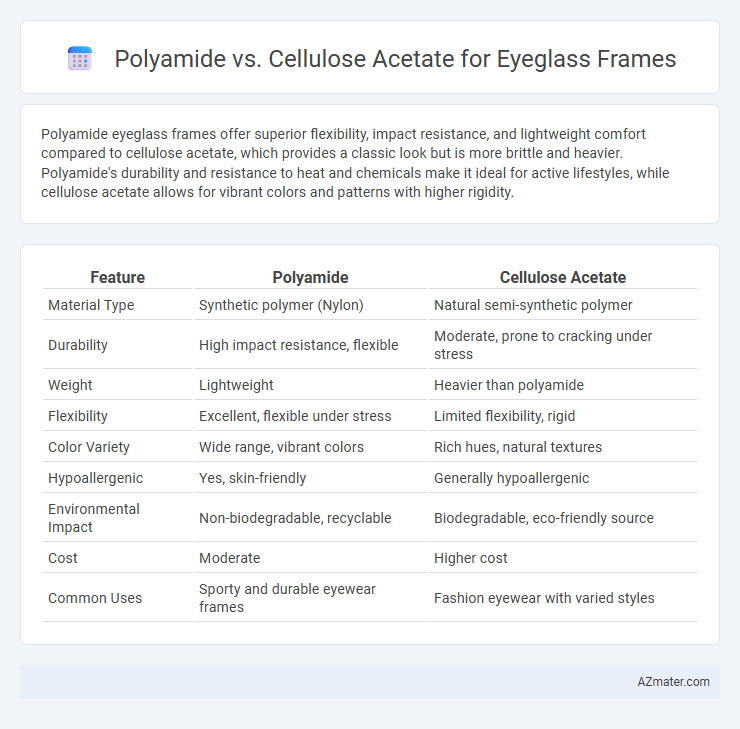Polyamide eyeglass frames offer superior flexibility, impact resistance, and lightweight comfort compared to cellulose acetate, which provides a classic look but is more brittle and heavier. Polyamide's durability and resistance to heat and chemicals make it ideal for active lifestyles, while cellulose acetate allows for vibrant colors and patterns with higher rigidity.
Table of Comparison
| Feature | Polyamide | Cellulose Acetate |
|---|---|---|
| Material Type | Synthetic polymer (Nylon) | Natural semi-synthetic polymer |
| Durability | High impact resistance, flexible | Moderate, prone to cracking under stress |
| Weight | Lightweight | Heavier than polyamide |
| Flexibility | Excellent, flexible under stress | Limited flexibility, rigid |
| Color Variety | Wide range, vibrant colors | Rich hues, natural textures |
| Hypoallergenic | Yes, skin-friendly | Generally hypoallergenic |
| Environmental Impact | Non-biodegradable, recyclable | Biodegradable, eco-friendly source |
| Cost | Moderate | Higher cost |
| Common Uses | Sporty and durable eyewear frames | Fashion eyewear with varied styles |
Introduction to Polyamide and Cellulose Acetate Eyeglass Frames
Polyamide eyeglass frames are known for their exceptional durability, flexibility, and lightweight properties, making them ideal for active lifestyles and long-term wear. Cellulose acetate frames, derived from natural fibers, offer superior color vibrancy, hypoallergenic qualities, and easy customization for a wide range of styles. Both materials provide distinct advantages in comfort and aesthetics, influencing consumer preferences in eyewear design.
Material Composition and Properties
Polyamide eyeglass frames consist of synthetic polymers known for their high durability, flexibility, and resistance to impact, making them ideal for active lifestyles. Cellulose acetate, derived from natural cotton fibers, offers a lightweight and hypoallergenic option with excellent color vibrancy and a smooth, glossy finish. While polyamide provides superior strength and flexibility, cellulose acetate excels in aesthetic versatility and comfort for sensitive skin.
Durability Comparison: Polyamide vs Cellulose Acetate
Polyamide eyeglass frames offer superior durability due to their high resistance to impact, flexibility, and resistance to cracking compared to cellulose acetate. Cellulose acetate, while known for its aesthetic appeal and ability to hold vibrant colors, tends to be more prone to brittleness and deformation over time under stress. The inherent resilience of polyamide makes it a preferred choice for long-lasting eyewear frames, especially in active or high-use environments.
Weight and Comfort in Everyday Wear
Polyamide eyeglass frames are lightweight and flexible, offering superior comfort for extended daily wear due to their resistance to impact and moisture. Cellulose acetate frames, while slightly heavier, provide a hypoallergenic and durable option with customizable aesthetics but may cause minor discomfort during prolonged use. Choosing polyamide enhances all-day comfort for active lifestyles, whereas cellulose acetate suits those prioritizing style with moderate wear periods.
Design Flexibility and Color Options
Polyamide eyeglass frames offer exceptional design flexibility due to their lightweight, durable, and moldable nature, allowing for intricate shapes and detailed textures that enhance aesthetic appeal. Cellulose acetate frames provide a broader spectrum of vibrant color options and custom patterns, benefiting from the material's ability to hold rich pigments and translucent effects. Both materials accommodate trendy designs, but polyamide excels in durability and thin profile options, while cellulose acetate leads in bold, diverse coloration and classic styling.
Hypoallergenic Features and Skin Safety
Polyamide eyeglass frames offer excellent hypoallergenic properties due to their inert chemical composition, reducing the risk of skin irritation and allergic reactions for sensitive wearers. Cellulose acetate, made from natural cotton fibers, is generally skin-friendly but may contain residual chemicals from manufacturing that can sometimes cause mild irritation in highly sensitive individuals. Both materials are lightweight and durable, but polyamide's superior resistance to skin allergens makes it a preferred choice for those prioritizing skin safety in eyewear.
Resistance to Heat and Environmental Factors
Polyamide eyeglass frames exhibit superior resistance to heat, maintaining structural integrity at temperatures up to 220degC, which prevents warping and deformation during exposure to high temperatures. Cellulose acetate, while offering good chemical resistance, tends to soften at lower temperatures around 80-90degC, making it less durable under heat stress. Environmental factors such as UV exposure and moisture have less impact on polyamide frames due to their enhanced durability and inherent flexibility, whereas cellulose acetate frames can become brittle and prone to color fading over time.
Price Differences and Market Availability
Polyamide eyeglass frames typically offer a cost-effective alternative, with prices ranging from $20 to $100, making them widely accessible in both budget and mid-range markets. Cellulose acetate frames generally command higher prices, often between $50 and $250, due to their premium feel and durability, which appeals to mid- to high-end consumers. Market availability of polyamide frames is broader in mass-market and online retail channels, whereas cellulose acetate frames dominate specialty eyewear stores and designer brand collections.
Sustainability and Environmental Impact
Polyamide eyeglass frames are valued for their lightweight durability and chemical resistance but rely on petroleum-based materials, contributing to environmental concerns such as non-biodegradability and carbon emissions. Cellulose acetate, derived from natural plant fibers like cotton or wood pulp, offers better sustainability through biodegradability and lower environmental toxin release during production. Choosing cellulose acetate frames supports eco-friendly practices by reducing plastic waste and promoting renewable resource use compared to synthetic polyamide alternatives.
Choosing the Right Material for Your Eyewear Needs
Polyamide frames offer exceptional durability, flexibility, and lightweight comfort, making them ideal for active lifestyles and daily wear. Cellulose acetate frames provide a wide range of vibrant colors and patterns, combined with hypoallergenic properties and eco-friendly sourcing, appealing to those prioritizing style and sustainability. Selecting between polyamide and cellulose acetate hinges on whether you value performance and resilience or aesthetic versatility and environmental consciousness in your eyewear.

Infographic: Polyamide vs Cellulose Acetate for Eyeglass Frame
 azmater.com
azmater.com